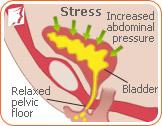
If you have finally entered the last phase of the menopausal journey, you'll be glad to hear that the worst of menopause symptoms is over, as your hormones have stopped fluctuating so severely and your body has had time to adjust. Unfortunately, though, many women may experience incontinence during postmenopause. Sometimes, this symptom doesn't fade as quickly as others.
There are three types of incontinence: stress incontinence, urge incontinence, and overflow incontinence. Stress incontinence is mostly likely to affect postmenopausal women, and for many, it is a distressing and embarrassing experience. Fear not - there are steps you can take to fight incontinence and prevent it from disrupting your life.
How Can I Combat Stress Incontinence in Postmenopause?

Stress incontinence is the most prominent type of incontinence and refers to the involuntary leak of urine when stress is put on the bladder walls. This usually happens when you sneeze, cough, laugh, exercise, or lean over to lift something up. Unfortunately, this happens to women more as they age because the pelvic muscles get weaker, which in turn weakens the walls between the bladder and vagina.
There isn't a magic cure for incontinence

It's important to discuss this problem openly with your doctor, though it may feel embarrassing at first. Some women believe that they are alone with this symptom, suffering in silence. In reality, 40% of postmenopausal women suffer from incontinence issues. Also, there are a variety of medications that can help reduce spasms in the bladder. Your doctor may also recommend a form of biofeedback training which, if done regularly enough, can help you regain bladder control. Any medication, surgery, or biofeedback should be recommended by your practitioner.
Hormone replacement therapy in postmenopause
If you are still using hormone replacement therapy (HRT) during postmenopause, it is also worth discussing with your doctor. Medical studies suggest that HRT can increase incontinence. Your doctor will be able to help you find the best course of action.
Kegel exercises

The main way to combat stress incontinence is to do Kegel exercises, which will help strengthen the pelvic muscles. The muscle you use to stop the flow of urine is your pelvic muscle. Lie on the floor and raise your pelvis off the floor. Hold your pelvis muscle tightly for five seconds and then release for five seconds. Do this several more times. Once you have perfected this technique, you can begin to vary the exercise.
Tighten the muscles and hold them tight, then release, before holding them again but slightly tighter. Release again and then tighten as much as you can the third time. You can also do this exercise at work or home. It works in any position. Try to do a set of 10 Kegel exercises at least three times a day.
More Information
Incontinence is a tiresome and distressing symptom for postmenopausal women, but you can improve it using the above strategies. Don't be afraid to talk to your doctor about the treatment options available to you. For more information on incontinence, follow the links below.
Sources
- National Institutes of Health. (2015). Stress urinary incontinence. Retrieved January 28, 2016, from https://www.nlm.nih.gov/medlineplus/ency/article/000891.htm
- Steinauer, J.E. et al. (2005). Postmenopausal Hormone Therapy. Does It Cause Incontinence? Obstetrics and Gynecology, 106(5 Pt 1), 940-945. doi: 10.1097/01.AOG.0000180394.08406.15


